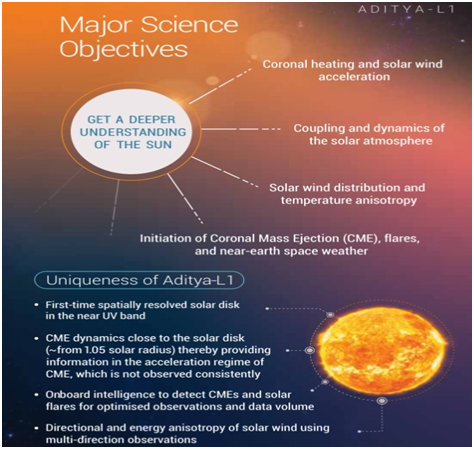Why in news?
- ISRO has announced that the Aditya-L1 mission, will be launched on September 2 from Sriharikota.
- Aditya L1 will be the first space-based Indian observatory to study the Sun.
What’s in today’s article?
- What is the Aditya-L1 Mission?
- What is the Lagrange point 1?
- Why is it important to study the Sun?
What is the Aditya-L1 Mission?
- About
- Aditya (in Sanskrit means Sun) is a planned coronagraphy spacecraft to study solar atmosphere (solar corona - outermost part).
- It has been designed and developed by ISRO and various other Indian research institutes.
- It is the first dedicated Indian mission to observe the Sun, and will be launched aboard a PSLV-XL launch vehicle.
- Objectives

- The suits of Aditya L1’s payloads are expected to provide crucial information for understanding the phenomenon of:
- coronal heating, coronal mass ejection(CME), pre-flare and flare activities and their characteristics,
- the dynamics of space weather, propagation of particles and fields etc.
- Placement of the spacecraft
- According to ISRO, the spacecraft will be placed in a halo orbit around the Lagrange point 1 (L1) of the Sun-Earth system.
- A satellite placed in the halo orbit around the L1 point has the major advantage of continuously viewing the Sun without any occultation/eclipses.
- This will provide a greater advantage of observing the solar activities and its effect on space weather in real time.
- L1 is about 1.5 million km from the Earth. It is expected to take more than 120 days for the spacecraft to reach the L1.
- Study conducted by Aditya L1
- The spacecraft carries seven payloads to observe:
- the photosphere [deepest layer of the sun we can directly observe],
- chromosphere [the layer about 400 km and 2,100 km above the photosphere], and
- outermost layers of the Sun (the corona), using electromagnetic and particle and magnetic field detectors.
- Of the seven playloads, four will directly study the Sun, and the remaining three will in situ study particles and fields at the Lagrange point L1.
- Remote sensing payloads which will study the sun
- Visible Emission Line Coronagraph (VELC) for corona/imaging and spectroscopy and CME;
- Solar Ultraviolet Imaging Telescope (SUIT) for photosphere and chromosphere imaging;
- Solar Low Energy X-ray Spectrometer (SoLEXS), which is a soft X-ray spectrometer for Sun-as-a-star observation; and
- High Energy L1 Orbiting X-ray Spectrometer (HEL1OS), which is a Hard X-ray spectrometer for Sun-as-a-star observation
- The payloads to study the L1 in situ
- Aditya Solar wind Particle Experiment (ASPEX), for solar wind/particle analyzer protons and heavier ions with directions;
- Plasma Analyser Package For Aditya (PAPA), for solar wind/particle analyzer electrons and heavier ions with directions; and
- Advanced Tri-axial High Resolution Digital Magnetometers for in situ magnetic field study.
What is the Lagrange point 1?
- A Lagrange pointis a position in space where the gravitational pull of two large masses precisely equals the centripetal force required for a small object to move with them.
- i.e., at that point, the gravitational attraction and repulsion between two heavenly bodies is such that an object placed between them will effectively stay in the same relative position while moving with them.
- These points in space can be used by spacecraft to reduce fuel consumption needed to remain in position.
- The Lagrange points are named in honour of Italian-French mathematician Josephy-Louis Lagrange, and there are five of them: L1, L2, L3, L4, and L5.
- L1 point of the Earth-Sun system affords an uninterrupted view of the Sun.
- It is currently home to the Solar and Heliospheric Observatory Satellite SOHO.
- NASA’s James Webb Space Telescope is at L2.
Why is it important to study the Sun?
- Every planet, including Earth and the exoplanets beyond the Solar System, evolves — and this evolution is governed by its parent star.
- The solar weather and environment affect the weather of the entire system.
- Variations in this weather can change the orbits of satellites or shorten their lives, interfere with or damage onboard electronics, and cause power blackouts and other disturbances on Earth.
- Knowledge of solar events is key to understanding space weather.
- To learn about and track Earth-directed storms, and to predict their impact, continuous solar observations are needed.
- Every storm that emerges from the Sun and heads towards Earth passes through L1.










